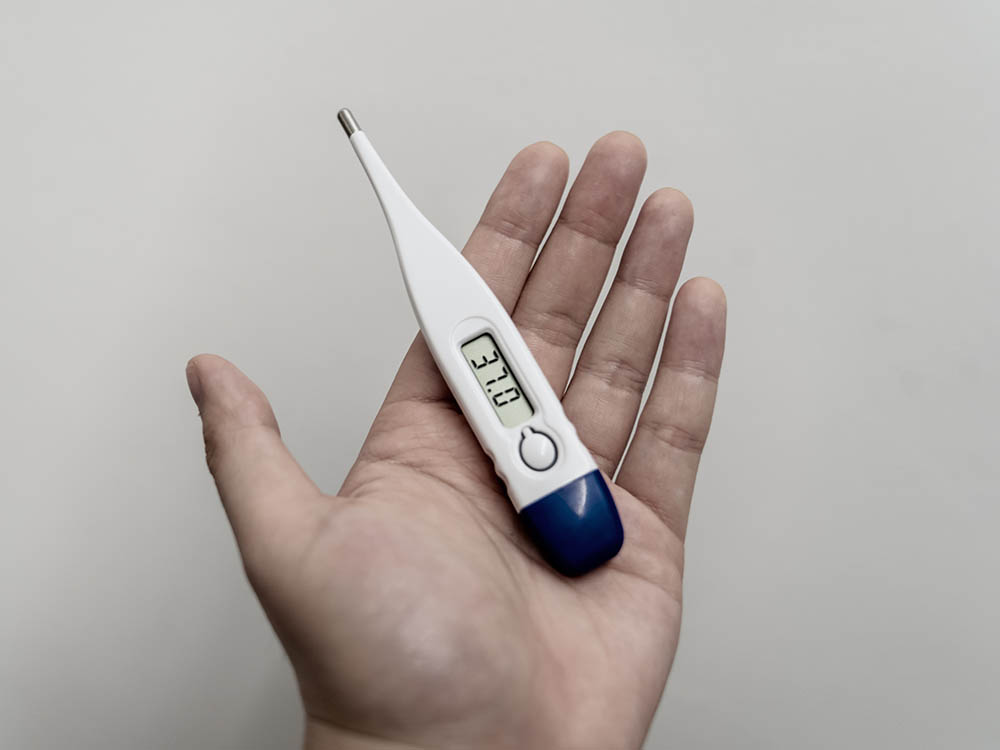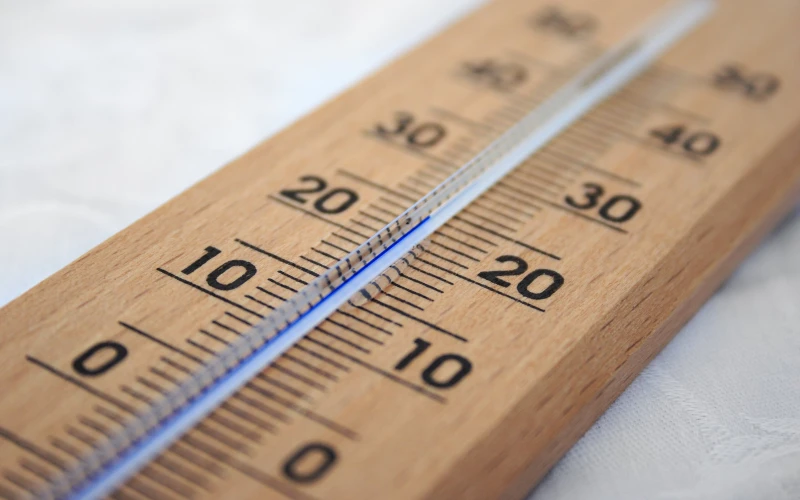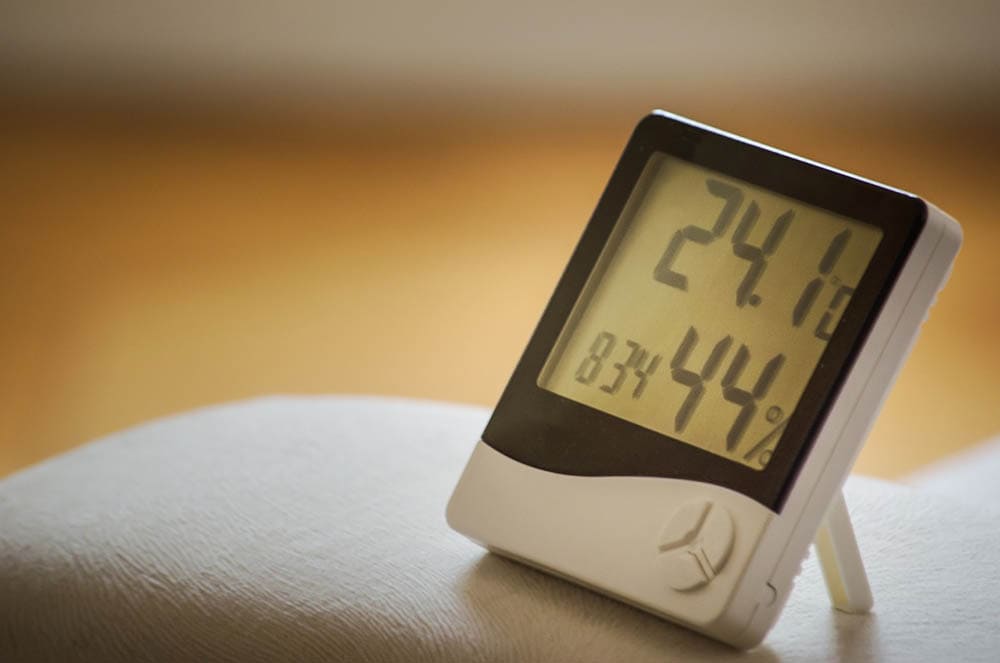How Does a Thermometer Work? Everything You Want to Know!
-
Chris Dinesen Rogers
- Last updated:

Probably one of your first experiences with a thermometer was your mom taking your temperature to see if you were sick. Your family may also have had an outdoor model to gauge how cold or warm it was outside. A thermometer works by measuring the amount of thermal expansion or contraction of a substance (such as mercury or alcohol) in response to changes in temperature. The device we know today was a work in progress that started with Italian physicist Galileo and Italian physiologist Santorio Santorio in the 17th century.
How Does It Work?
It’s essential to begin with a few terms to understand how a thermometer works. The word itself comes from the French “thermomètre” phrase meaning “hot” and “measure”.1 Heat describes the movement of thermal energy, going from something warm to cold. Think of the heat transfer occurring in a glass of ice water as the liquid cools down as the cubes melt.
Temperature refers to a different type of energy called kinetic or energy in motion. It pertains to the molecules and how fast—or slow—they’re moving. You might remember from your high school science class that heat speeds up reactions.
A thermometer demonstrates these concepts in real time. The liquid within the device expands as the temperature rises, causing it to climb up its length. Likewise, it contracts when it cools. The first thermometer used water, which, of course, limited its usefulness. Later, scientists used alcohol, which has a freezing point of -174.6℉ (-114.7℃).2 Simply add some dye, and you have a working thermometer.
Fast forward to 1714 to inventor Daniel Gabriel Fahrenheit. He used mercury instead of alcohol, which reacts similarly but more rapidly. A thermometer isn’t much good without a scale. Fahrenheit based his on the lowest temperature reached when a mixture of ammonium chloride, salt, and ice freezes. It’s unclear why he chose 32℉ for freezing and 212℉ for boiling. However, it’s the scale we know in the United States.
What Are the Different Types of Thermometers?

The scale is one differentiating factor between the types of thermometers. The other one used in the rest of the world and probably in your science class is based on Celsius, developed by Swedish physicist Anders Celsius. He had the same idea with a freezing and boiling point. The difference was that he used 0℃ for the former and 100℃ for the latter. It makes sense when juxtaposed with the metric system.
The other one worth discussing is the Kelvin scale. Scientists use it to measure molecular motion, as we talked about earlier. It quantifies the point where it ceases. Remember that molecules move, albeit in a confined manner. However, this scale is based on theory instead of actual observations.
The bulb thermometer is the type you probably used as a child. It operates on the principles we discussed earlier. The US Environmental Protection Agency (EPA) has put in motion a plan to phase them out, issuing its final rule in January 2012.3 Its well-documented toxicity prompted this action. It also accumulates in the environment and can kill aquatic organisms.4
Electronic thermometers have replaced bulb types for many people. They use another physics principle involving electricity and resistance. As the temperature of the probe increases, so too does the movement of molecules with its ramped-up resistance, impeding the flow of electricity. A microchip inside the device measures the resistance as a function of temperature. An instant-read thermometer is another example.
Dial thermometers, often used outdoors, are based on the expanding-contracting principle using a bimetallic strip to do the heavy lifting. Heat has the same effect as it does with alcohol or mercury. Calibration is essential for ensuring accurate readings.
Infrared thermometers work by detecting radiation from distant objects. It also relies on the movement of molecules. Heat is converted to electricity, which then registers the temperature.
Where Is It Used?

Thermometers are used anywhere and anytime where knowing the temperature is vital. You’ll find various forms used in the medical field since a fever is a sign of an infection triggered by the body’s immune system. Your veterinarian will use one on your dog or cat during an exam. If you have an aquarium, you’re well aware of how critical the water’s temperature is for keeping your fish healthy.
Other everyday examples include baking, cooking, grilling, and food safety. Thermometers are invaluable in meteorology, manufacturing, aviation, and numerous other industrial applications.
Advantages of a Thermometer
The advantages of a thermometer are too many to list. It has given users more precision for however they use one. That can make procedures safer and more efficient, leading to more favorable outcomes. It also buys time when it comes to health applications. For example, cats are notorious for hiding signs they’re sick until a condition has progressed. Knowing your pet has a fever can help you get a head start on treating it.
Disadvantages of a Thermometer
The main disadvantage of thermometers rests with a type that the EPA has already identified as hazardous to humans and the environment. It also isn’t the most accurate kind. Digital thermometers far exceed their precision. That can make a significant difference in some situations.
The transition from the older technology will occur on a case-by-case basis. Researchers must develop reliable and accurate alternatives. Fortunately, the National Institute of Standards and Technology (NIST) is actively working on these measures.
Frequently Asked Questions (FAQs)
How accurate are digital thermometers?
These thermometers can push the accuracy bar to within 0.001℃.
Which is better, the Fahrenheit or Celsius scale?
Both scales are practical for the people who use them. Plotting them on a graph yields the same linear relationships, making them virtually identical. An increase of 18℉ is the equivalent of 10℃.
How do pop-up thermometers in whole turkeys work?
These devices are a brilliant example of refining the technology for a specific use. The pop-up is spring-loaded and held in place by a metal ball. Once your turkey reaches the trigger temperature, it melts and releases the red timer. The temp is about 185℉. Notably, the USDA recommends 165℉ for the internal reading. Therefore, we suggest cooking your bird the old-fashioned way with an instant-read thermometer.
A Temperature Quick Reference Guide
| Temperature | Fahrenheit | Celsius | Kelvin |
| Boiling Point | 212℉ | 100℃ | 373.15° |
| Freezing Point | 32℉ | 0℃ | 273.15° |
| Absolute Zero | -459.67℉ | -273.15℃ | 0° |
Source: https://www.livescience.com/temperature.html
Conclusion
The thermometer is just one example of how science has made our lives easier and safer. Even if you’re not into physics, it’s hard not to appreciate the technology scientists have developed. This simple device is a prime example. It went from an idea based on observation to becoming one of the most valuable inventions of all time. Thanks to pioneers like Galileo and Daniel Gabriel Fahrenheit, we know what the temperature really is.
- https://www.pdcnet.org/jems/content/jems_2018_0007_0001_0073_0103
- https://www.etymonline.com/search?q=thermometer&ref=searchbar_searchhint
- https://news.ncsu.edu/2011/07/wms-alcohol-freezing/
- https://www.epa.gov/mercury/phasing-out-mercury-thermometers-used-industrial-and-laboratory-settings
- https://www.livescience.com/33015-mercury-thermometers-are-going-extinct.html
- https://www.livescience.com/32134-what-causes-a-fever.html
- https://www.foodsafety.gov/food-safety-charts/safe-minimum-internal-temperatures
- https://www.livescience.com/temperature.html
Featured Image Credit: Winel Sutanto, Unsplash
Contents


